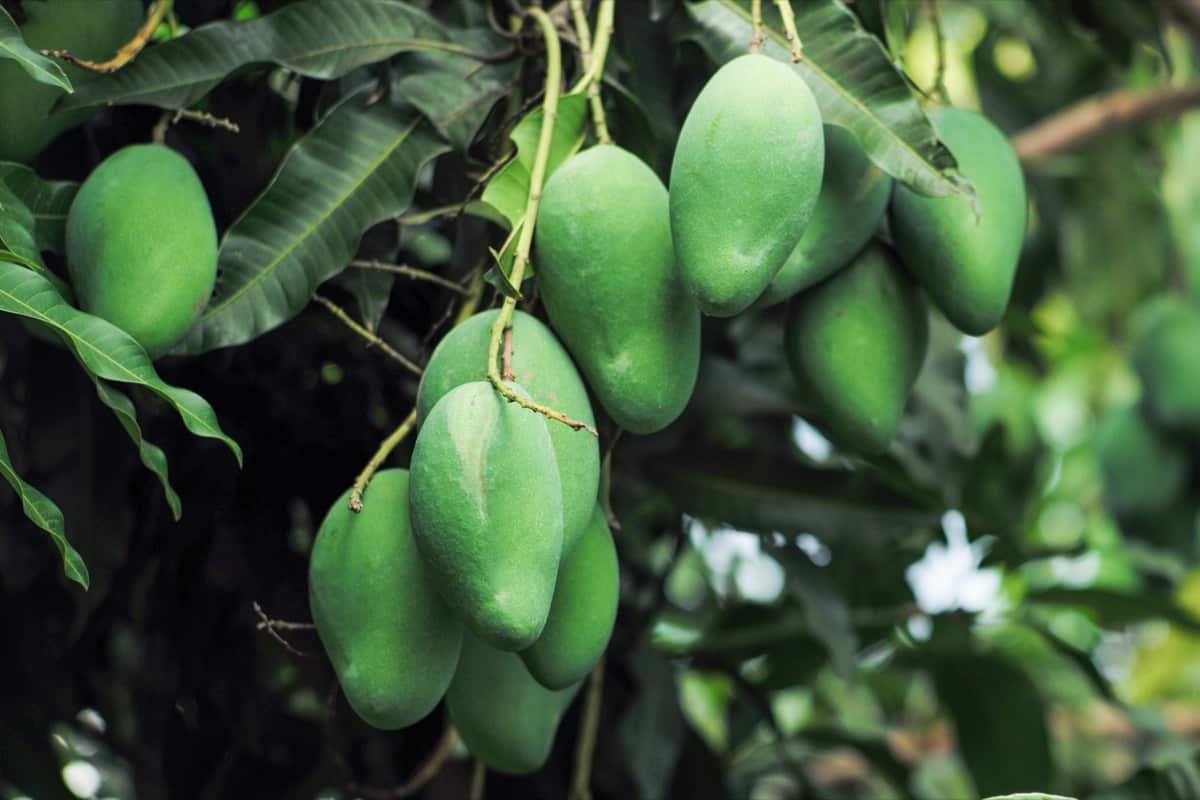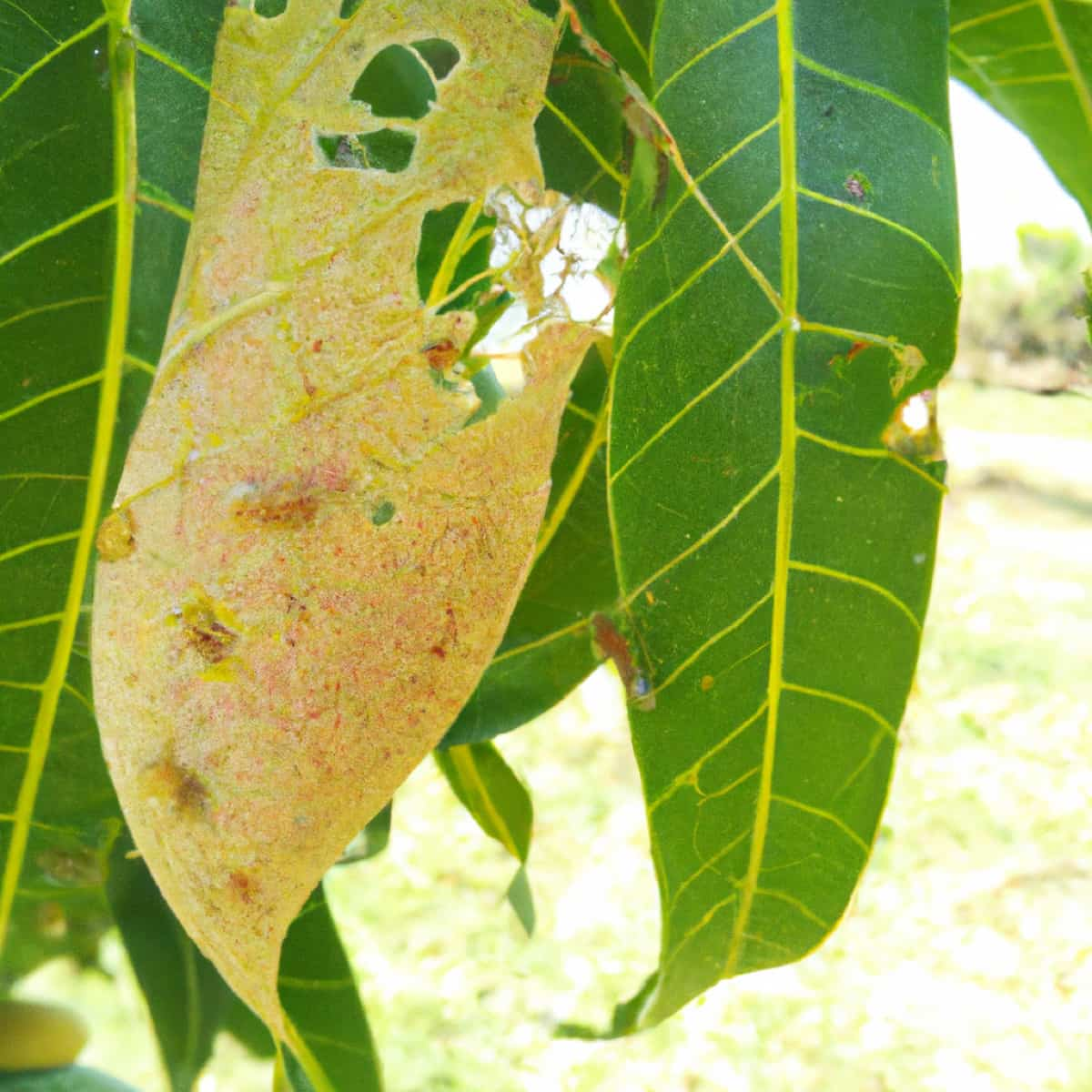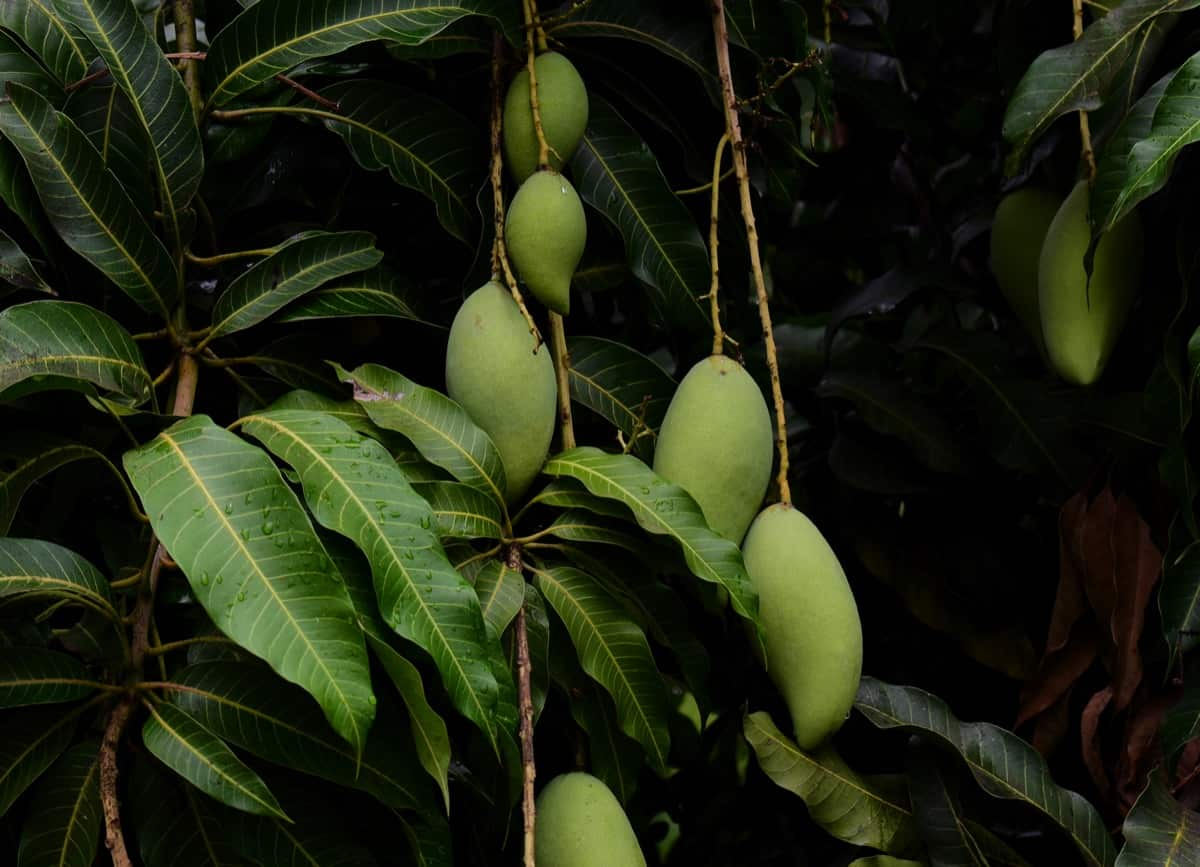The Mango Leaf Webber, Orthaga exvinacea, belonging to the Family Noctuidae of the Order Lepidoptera, is also known as Mango Shoot Webber or Indian Acacia Moth. This pest is native to India and parts of South-East Asia. The larvae feed on the underside of the leaves of mango trees, creating large webs that can completely cover the foliage.

The caterpillars can also feed on flowers and fruits, reducing crop yield and quality. To effectively manage this pest, it is iessentialto understand its life cycle, its preferred habitats, and the best methods for controlling it. This article will provide an overview and discussion of the Mango Leaf Webber Pest in Mango crops, including its symptoms, identification techniques, and control.
Leaf Webber Pest Management in Mango
Life Cycle of Mango Leaf Webber Pest in Mango Crop
The life cycle of the mango leaf webber pest has four stages. They are egg, larva, pupa, and adult. The egg stage begins when the female adult lays its eggs on the underside of the mango leaves. They hatch within a few days. After hatching, they move around the leaves, feeding on the underside of the mango tree leaves, causing web-like damage to the leaves.
The larvae undergo five instars and feed for about three weeks before pupating. The larvae then enter the pupal stage, forming a cocoon around themselves. The pupae are often found attached to the underside of the mango leaves and remain there for about a week. After a week, the pupae will transform into adults.
The adults are small, white moths that feed on the mango leaves, live for only a few days, and do not feed. They mate and lay their eggs on the underside of the leaves. This cycle will repeat itself for several generations, with the moths laying eggs and the larvae feeding on the leaves, thus causing extensive damage to the mango crop. The entire lifecycle is completed in six weeks.
Occurrence of Mango Leaf Webber Pest in Mango Crop
- Location of Mango Leaf Webber pest: This pest infests mango crops in India, Thailand, Australia, Africa, Mexico, the Philippines, the United States, China, Japan, Brazil, and Indonesia.
- Host range: The mango leaf webber pest infects crops like Mango, oranges, lemons, limes, papayas, guavas, bananas, and figs.
Factors Favoring the Population Increase of Mango Leaf Webber Pest in Mango Crop
- Warm and humid climate is ideal for developing and reproducing the pest. The high temperatures and ample moisture create a favorable environment for the larvae to feed and develop.
- Chemical pesticides kill beneficial insects, like ladybugs and lacewings, which feed on leaf webber larvae.
- The presence of other insect pests and diseases, such as powdery mildew and other fungal diseases, may provide food for the larvae.
- Over-fertilization can increase the nitrogen and phosphorus content in the soil, creating an ideal environment for the larvae to feed and develop.
- The presence of alternate hosts, like citrus spp., figs, papayas, etc., allows the pest to build up its population quickly.
Identification of Mango Leaf Webber Pest in Mango Crop
- Eggs: The eggs are yellowish-green, about 1.4 mm in size, and laid in clusters of up to 50.
- Larvae: The larva is a small, pale-green caterpillar with a brown head, a prothoracic shield, and short legs.
- Pupa: The pupa is long and brownish and remains attached to the leaves.
- Adults: The adult moth is a small, black, and yellow moth with wavy stripes on the forewings and a wingspan of up to 1.5 cm. Males are smaller than females.
In case you missed it: Mealybug Pest Management in Mango: Symptoms, Treatment, Chemical, Biological, Natural, and Organic Control

Damage Symptoms of Mango Leaf Webber Pest in Mango Crop
- The caterpillars feed on the leaf surface voraciously and scrap the chlorophyll after hatching from the eggs.
- After a while, the caterpillars create a web of silk on terminal leaves and tender shoots and feed on them from the inside.
- The webbing can give the leaves a matted, tattered appearance.
- The caterpillars can feed directly on the leaves, leaving holes and ragged edges behind.
- Withering and Drying of the plants occur due to the scrapping of the chlorophyll in the early stages.
- The caterpillars feed directly on the fruits, leaving behind brown spots and scars. The fruits may also become soft and discolored due to the damage.
Percentage of Yield Loss in Mango due to Mango Leaf Webber Pest
- In India, the yield losses due to mango leaf webber pests are up to 40%. In Bangladesh and Colombia, the percentage of yield loss is around 30% and 20%, respectively. In China, the losses are up to 15%. In the United States, the losses are 10%. In Mexico and Brazil, it is 5% and 10% respectively. In Africa, it is at 10%. In Australia, it ranges between 5-10%. In Indonesia, the yield losses are 50%. In Thailand, it is 35%. In the Philippines, it is 40%.
- The Economic Threshold Level (ETL) for the mango leaf webber pest is set at 10-20 webbers per tree.
Cultural Control of Mango Leaf Webber Pest in Mango Crop
- Rotational cropping helps break the pest’s life cycle by depriving it of food sources.
- Pruning branches and twigs help reduce the pest impact on crop yields.
- Mulching helps reduce the moisture around the tree’s base and discourages the pest from laying eggs.
- Using yellow sticky traps helps monitor the webber population levels.
Biological Control of Mango Leaf Webber Pest in Mango Crop
- Natural Predators, such as carabid beetle and reduviid bug, feed on the pest’s larvae and adults, reducing their population.
- Parasitoids, such as Hormiusa spp., feed on the eggs and larvae of the pest.
- The beneficial fungi, such as Beauveria bassiana and Paecilomyces farinosus, can also help to reduce pest populations.
Chemical Control of Mango Leaf Webber Pest in Mango Crop
- Spray Carbaryl, Endosulfan, Monocrotophos, or Quinalphos from the last week of July at 15-day intervals.
- These chemicals are usually applied either through soil or foliar application.
Organic Control of Mango Leaf Webber Pest in Mango Crop
- Using insecticidal soaps, chilli, and oils, such as neem oil, can help control pest populations.
- Neem oil is used as sprays and dust to control the pest population.
- Chilli is also used as sprays and dust to deter the pest from feeding on the mango crop.
Preventive Measures for Control of Mango Leaf Webber Pest in Mango Crop
- ‘Planting resistant mango varieties can also help reduce the risk of leaf webber infestations. Some varieties, such as the Mangalur variety, produce a bitter sap that repels the pest, whereas’‘Alphons” and”Kesar’ also naturally resist the pest.’Planting resistant mango varieties can also help reduce the risk of leaf webber infestations. Some varieties, such as the Mangalur variety, produce a bitter sap that repels the pest, whereas ‘Alphonso’ and ‘Kesar’ also naturally resist the pest.
- Intercropping of mangoes helps to create a more diverse environment that is less conducive for the pest to thrive.
- Perform Sanitation activities by removing and destroying dead wood and infested parts of the tree.
In case you missed it: Bark Borer Pest Management in Mango: Symptoms, Treatment, Chemical, Biological, Natural, and Organic Control

Conclusion
The Mango Leaf Webber Pest is an essential pest of mango crops, causing significant economic losses to mango production. It is highly adaptable, so effective management strategies are necessary to reduce the impact of the Mango Leaf Webber Pest on mango crops. Integrated pest management strategies, such as natural predators, chemical insecticides, and cultural practices, can help reduce the Mango Leaf Webber Pest population and protect crops from significant damage.
- Deworming Schedule for Dogs/Puppies: A Beginners Guide
- How to Prevent and Control Parasites in Goats
- Beneficial Insects in Pest Management
- Natural Solutions for Pest Control in Flower Gardens
- Types of Fungicides Used in Agriculture
- Common Issues in the Fruit Development Stage of Pomegranate Farming
- Fruit Development Issues in Papaya: Easy Solutions and Treatment
- Soil-Borne Diseases and How to Protect Your Plants
- Practices to Prevent Disease Spread in the Garden